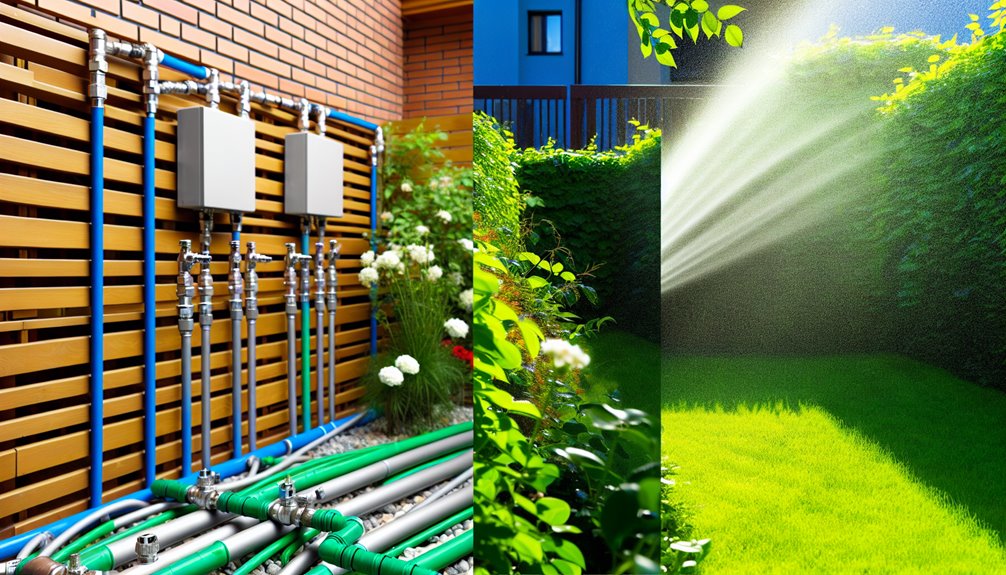Up to 80% of mosquito bites occur within 100 feet of your home, so your control strategy matters. You’re weighing a barrier spray’s residual protection against an automated misting system’s timed bursts. Each handles yard size, pest pressure, and season differently, and both carry safety and environmental trade-offs. Costs and maintenance can also sway your decision. If you want fewer bites without unnecessary chemical use, you’ll need to match the method to your yard’s risk profile and routine.
How Each Option Works and What Coverage to Expect

Picture a perimeter shield around your yard: barrier sprays create a residual chemical film on vegetation and structures that kills or repels mosquitoes for 2–4 weeks, while misting systems release short, automated bursts of insecticide into the air to knock down flying adults on demand. You’ll treat foliage, shaded harborage, and building eaves for contact kill and residual control; expect uniform coverage where leaves are hit. Misters distribute fine droplets from fixed nozzles; expect effective zones within line-of-sight and prevailing airflow. Verify label rates, wind limits, and reentry intervals. Calibrate nozzles, log spray duration, and schedule pulses to balance efficacy with system flexibility and stewardship.
Pros and Cons for Different Yards and Lifestyles
Now that you know how each method delivers coverage, match them to your yard and routine. For small lots, barrier sprays are cost-efficient, require fewer components, and limit visible equipment. They suit busy schedules and rental situations but need reapplication and careful timing around kids, pets, and pollinators. For large yard size or complex landscaping, misting systems provide consistent dosing and hands-off operation. They require upfront installation, routine maintenance, and safe storage of concentrates. Consider lifestyle preferences: frequent outdoor hosting benefits from automation; volunteer-heavy households may prefer scheduled treatments. Always follow label directions, drift controls, reentry intervals, and local regulations.
Effectiveness by Pest Type and Season

Although both methods target flying and biting pests, their performance varies by species and season. You’ll see barrier sprays excel against ticks and ground-resting mosquitoes because residues intercept host-seeking paths. They also reduce wasps at nesting sites. Misting systems outperform during peak dusk/dawn mosquito flights, black flies, and midges, delivering space knockdown when pest behavior concentrates aloft. In cool springs, barrier sprays persist as adults emerge slowly; in hot, humid summers with rapid cycles, timed mists disrupt swarms. Late-season, combine residual barriers for ticks with targeted mists during warm evenings. Always align intervals with life stages and seasonal adaptations to protect guests reliably.
Safety, Environmental Impact, and Chemical Use
Before you choose an approach, weigh how each system exposes people, pets, and non-target organisms to active ingredients. Barrier sprays apply controlled doses to vegetation, reducing drift but concentrating residues. Misting systems aerosolize smaller particles, increasing inhalation and off-target exposure risks. Prioritize chemical safety by selecting EPA-registered actives, following label rates, and timing applications to avoid pollinators.
- Assess exposure: map play areas, pet zones, and flowering plants; establish no-spray buffers.
- Reduce load: choose targeted actives, integrate habitat modification, and limit frequency.
- Maximize environmental benefits: prevent runoff, avoid water bodies, and verify equipment calibration to minimize waste and ecological harm.
Costs, Installation, and Ongoing Maintenance

While both approaches control mosquitoes, they differ markedly in upfront price, complexity, and lifetime upkeep. Barrier spray programs carry low installation costs—often just a service visit—and predictable per-application fees every 3–4 weeks. You’ll budget for licensed applicators, product, and weather-driven re-treatments. Misting systems require higher installation costs for tanks, pumps, lines, and nozzles, plus electrical or battery power. Maintenance considerations include nozzle clogging, leak checks, calibration, and pesticide refills. You’ll schedule seasonal winterization and annual inspections for safety and compliance. Choose a configuration that prioritizes accurate dosing, documented service records, and neighbor-safe drift control, especially when protecting shared spaces.
Conclusion
In the end, it really comes down to what works best for your unique yard and lifestyle. I understand that choosing between a barrier spray and a misting system can be overwhelming, but I’m here to help you navigate those options. If you have a cozy space and want effective tick and mosquito control, a barrier spray might just be your best bet. On the other hand, if you love spending time outdoors during peak mosquito hours, a timed misting system could offer you the convenience you need. Whatever you decide, remember to always prioritize safety and evidence-based practices. If you have any questions or need assistance, feel free to reach out! I invite you to visit us at mosquitoeliminatorsms.com or give us a call at (601) 336-2277. Let’s work together to make your yard a pest-free paradise!

